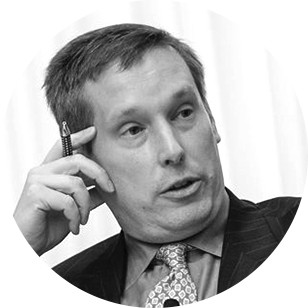Reflections from the Secret Service agent who leaped onto JFK's car
"I think about it every day," says retired Secret Service agent Clint Hill. "It never goes away."
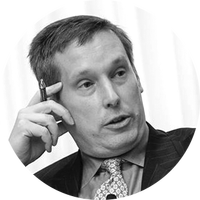
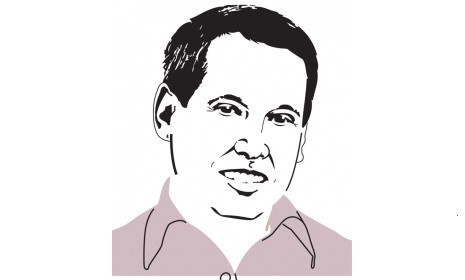
DALLAS — It is the most famous home movie of all time. Just 26 seconds in length, it shows, in gruesome detail, the Nov. 22, 1963 murder of President John F. Kennedy.
In the clip — known as the "Zapruder film," for Dallas dressmaker Abraham Zapruder, who shot the footage — a Secret Service agent is seen running toward Kennedy's limo. As the car speeds up, the man struggles to hop on. He grabs a rung, nearly slips, and pulls himself aboard. Pushing Jacqueline Kennedy back into the car, he drapes his body over hers and the fatally-wounded president as the car speeds to Parkland Memorial Hospital.
That man, Clint Hill, told me all about it in 2010 — as he led me on a tour of the crime scene.
The Week
Escape your echo chamber. Get the facts behind the news, plus analysis from multiple perspectives.

Sign up for The Week's Free Newsletters
From our morning news briefing to a weekly Good News Newsletter, get the best of The Week delivered directly to your inbox.
From our morning news briefing to a weekly Good News Newsletter, get the best of The Week delivered directly to your inbox.
"I think about it every day," he said. "It never goes away."
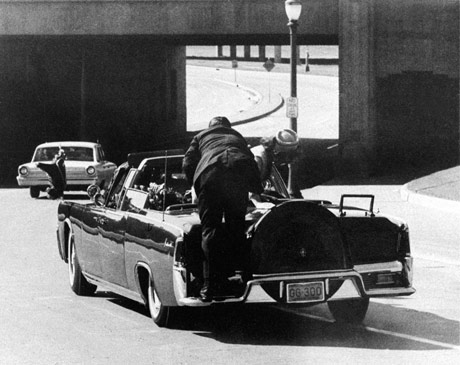
Clint Hill rides on the back of the president's car moments after Kennedy is shot on Nov. 22, 1963.
(Photo: AP Photo/Ike Altgens)
Gruesome memories
A free daily email with the biggest news stories of the day – and the best features from TheWeek.com
Walking down Elm Street, the old Texas School Book Depository building loomed over our shoulder as Hill recalled in vivid, excruciating detail what happened right after SS100x — the presidential limousine — made the sharp left turn off Houston Street at 12:30 p.m.
"He (driver Bill Greer) began to accelerate slightly. And just as he began to get to the original speed of 11, 12 miles per hour, I heard a noise from my right rear — an explosive sound. I had been scanning to the left side of the streets; there were a few people in the grassy area. And as I heard that explosive noise, my scan took me across the presidential vehicle moving to my right. When I did so, I saw the president grab his throat, lurch to his left, and I knew that something had happened. I jumped off the follow up car and ran toward the presidential vehicle. During that run, apparently there was another shot, which I did not hear. Just before I reached the presidential vehicle, a third shot rang out. I heard it and I felt it because it hit the president in the head above the right ear to the rear portion of his head.
Brain matter and blood spewed out of that wound and I was covered with it as was the car. Mrs. Kennedy at that time came out on the back of the trunk of the car attempting to retrieve something that had come off the president's head, which was the right rear. She didn't know I was there. I did the best I could to place her into the back seat, got her into the back seat. The president fell over into her lap. His head was exposed. I could see his eyes were fixed. The upper right portion of his head was split open. It looked like somebody had taken a spoon or something and removed brain matter and spread it all around the back of the car, along with blood, all over Mrs. Kennedy and everybody else. So I placed myself up as high as I could above them to prevent anybody from shooting any more into the car. The driver accelerated and we sped off."
All that happened in six seconds.
During the frantic race to the hospital, as SS100X reached speeds of 80 mph, Hill turned to the follow-up car and gave the thumbs down. He banged his fist on the trunk in agony.
"They didn't officially declare him dead until 1:00. But I knew from the moment I got on top of the car and looked down into his face that he was dead."
It was clearly difficult for Hill to recount this awful tale. He paused several times, clearing his throat and occasionally looking down.
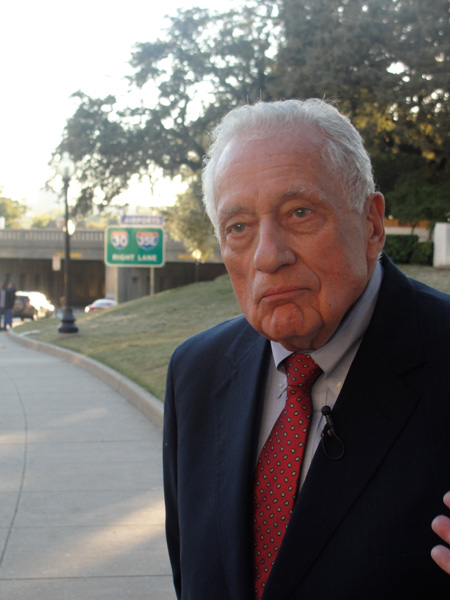
The stare says it all: Clint Hill in front of the famous grassy knoll.
(Photo/Paul Brandus)
Who did it?
From Hill's perspective, there was no conspiracy. Lee Harvey Oswald, from his sixth-floor perch in the book depository, planned and carried out the assassination on his own.
"I think they got it pretty much right," Hill says. "I believe there were only three shots, that they came from the right rear from an elevated position from the school book depository. The rifle used was the same rifle used for all three shots and it turned out to be Lee Harvey Oswald as the shooter. So I think they got it right."
But Hill says the infamous Warren Commission erred in not calling enough witnesses, namely two agents who were with Hill in "Halfback" — the Secret Service car directly behind the presidential vehicle.
"If they would have asked us — we would have had the follow-up car driver (Sam Kinney) and the shift leader (Emory Roberts) testify because both of them saw all three shots find their mark. And that testimony was lost, because they're both dead."
Hill says their testimony would have helped solidify the Warren Commission's view that Oswald was the lone gunman. Three spent cartridges were found in the sniper's nest on the book depository's sixth floor; finger and palm prints on boxes in the sniper's nest, fibers from Oswald's shirt in the rifle — and eyewitnesses who saw him standing in the window with the rifle moments before the assassination. The evidence, they say, is overwhelming. Meantime, the "magic bullet" theory has since been debunked by technology and knocking down some commonly-held, but false, assumptions. After all this time, no hard proof has ever surfaced that anyone else fired a shot or was involved in any way.
But many Americans still believe Oswald must have had some help: Cubans, the Mafia, CIA, even Lyndon Johnson figure in their theories. An earth-shattering crime of such monstrous proportions simply couldn't have been committed by just one person, they say. Hill’s response: Nonsense.
"There's one person that shot Martin Luther King, there's one person that shot Bobby Kennedy, there's one that shot George Wallace, there's one person that shot Ronald Reagan," he told me. "So it's been one person almost every time."
The other three presidents killed in office — Lincoln, Garfield and McKinley — also died at the hands of a lone gunman, Hill adds.
Endless nightmare
Hill spent decades wallowing in guilt after the assassination.
"I went down to the basement with alcohol and cigarettes and stayed there several years," he says. He broke down on 60 Minutes in 1975, saying President Kennedy's death was all his fault.
Hill never thought he would — or could — return to Dallas. But in 1990, after a Secret Service convention in San Antonio, he decided to go. He didn't tell anyone.
"I spent some time out on Elm Street, in the Dealey Plaza area, in the school book depository and I finally came to the conclusion that, after looking at everything, that what I did on Nov. 22, 1963, I did as much as I could do. I couldn't have done more."
After 27 years, it was cathartic, he says.
"It gave me a sense of relief. At least I tried to intervene, even though I still feel a sense of responsibility that I was unable to provide the protection that we had promised and guaranteed that we would provide. At least I had tried. And I was the only agent who had a chance to try. None of the other guys had an opportunity. Only myself."
Hill signed the guest book at the sixth floor museum — using a different name. He didn't want anyone to know he had been there.
That was 1990. As we chat, it is clear that even today — after nearly half a century — it is an ordeal for him to come to this place.
"It's quite emotional for me to be here. I don't have the nightmares on a constant basis like I used to have. But it's still there, and anytime I hear anything on the radio or on TV or read something in the paper — there always seems to be something about JFK or Mrs. Kennedy or the Kennedy children, it brings back good memories, but also bad memories of November 22, 1963."
An award-winning member of the White House press corps, Paul Brandus founded WestWingReports.com (@WestWingReport) and provides reports for media outlets around the United States and overseas. His career spans network television, Wall Street, and several years as a foreign correspondent based in Moscow, where he covered the collapse of the Soviet Union for NBC Radio and the award-winning business and economics program Marketplace. He has traveled to 53 countries on five continents and has reported from, among other places, Iraq, Chechnya, China, and Guantanamo Bay, Cuba.
-
 Zimbabwe’s driving crisis
Zimbabwe’s driving crisisUnder the Radar Southern African nation is experiencing a ‘public health disaster’ with one of the highest road fatality rates in the world
-
 The Mint’s 250th anniversary coins face a whitewashing controversy
The Mint’s 250th anniversary coins face a whitewashing controversyThe Explainer The designs omitted several notable moments for civil rights and women’s rights
-
 ‘If regulators nix the rail merger, supply chain inefficiency will persist’
‘If regulators nix the rail merger, supply chain inefficiency will persist’Instant Opinion Opinion, comment and editorials of the day
